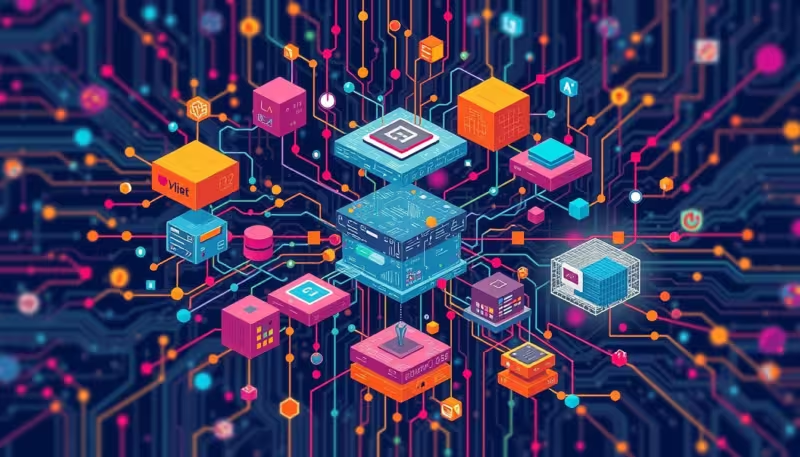Today’s tech scene is constantly changing. Microservices architecture is now key for getting past old monolithic system limits. By breaking down complex applications into smaller, self-sufficient units, this method boosts app development scalability. It also makes maintenance simpler. More and more organizations see the benefits of moving from monoliths to microservices. They find it essential for meeting user demands and complex business requirements.
Consider Shopify’s main app, for example. It has more than 2.8 million lines of code and 500,000 commits. Shopify handles huge traffic spikes during big sales events, like Cyber Monday, with ease. Their success comes from the modular setup of their code. This detailed look into microservices will discuss the drawbacks of monolithic systems. It will show why businesses today need a flexible, modular strategy in creating software.
Understanding Monolithic Architecture
Monolithic architecture is a way to design software where all parts come together as one. User interface, database, and server parts are all connected. They must work together to work well. It’s like combining everything you need into one big package. It has one main code, one way to deploy it, and shares data. This makes it easy and fast for developers to start building with it.
Definition and Characteristics
This architecture is like a one-piece puzzle. It has three key parts: client UI, database, and server application. It’s simpler for teams because it doesn’t need a lot of planning at the start. Finding and fixing bugs is easier because everything is in one place. However, making changes might impact many parts at once because everything is so connected.
Common Use Cases of Monolithic Systems
Startups and small projects often pick monolithic systems for their simplicity. It’s great for getting things started quickly. Banks use it for their stable and old systems. E-commerce sites find it helpful for keeping track of sales and data all in one place. This architecture helps manage a lot of tasks together smoothly.
Challenges Faced with Monolithic Structures
But, monolithic architecture can get tricky as projects get bigger. Making the whole system bigger or adding new stuff can be hard. Deploying updates takes longer, which can cause big problems. Big companies like Netflix and Atlassian saw these issues when they grew. They had to move to different setups to keep up with changes and growth.
The Need for Microservices Architecture
The need for microservices comes from wanting to improve design and get past old limits. As apps get bigger, moving to microservices helps businesses upgrade their development work. It lets them better meet what users expect.
Why Transition from Monolith to Microservices?
Businesses turn to microservices for scalable solutions that meet user needs. Old-style, single-block apps can be hard to update with new features. Microservices let developers add features on their own. This improves reliability and lowers the chance of big problems.
These independent services lead to quicker development and easier fixes during tests.
The Impact of User Demand on System Design
Users want apps that are fast and reliable, forcing businesses to change. Microservices make adding new parts smoother. This boosts work efficiency and speeds up product release.
With each microservice working alone, teams can refine their workflow. They follow the “two-pizza rule” for smaller, more effective teams. Companies using this method have seen major gains in meeting user needs without the big challenges of large, unwieldy systems.
Microservices Architecture in Practice
At the heart, microservices architecture breaks down applications into smaller, independent services. Each service tackles a unique business task, and they work together. This method allows for easy scaling and flexible software building. Unlike monolithic applications, where a single error can cause widespread problems, microservices limit these risks.
Defining Microservices Architecture
Microservices mean creating apps with many small, loosely connected services. Each service focuses on a certain business area, letting teams work fast and independently. This setup is different from traditional, large applications that are hard to update and scale.
Architectural Components and Their Functions
Microservices architecture relies on several key components:
- API Gateway: Acts as the main path for client requests, managing communication with different services.
- Service Discovery: Finds services automatically, making it easier for microservices to talk to each other without preset arrangements.
- Data Management: Gives each microservice its own database, which helps with performance and customized data handling.
- CI/CD Pipelines: Speeds up deployments with automated processes, contrasting with the slow updates typical of monolithic apps.
- Monitoring and Logging: Keeps the system running smoothly, quickly identifying and fixing any issues.
Benefits of Adopting Microservices Architecture
Switching to microservices architecture brings many benefits. It makes a company more agile and innovative. By splitting applications into smaller services, companies can scale up easily. This helps them stay competitive in today’s fast-moving digital world.
Increased Scalability and Flexibility
Microservices boost scalability. Each service can operate on its own, using its resources. This approach helps avoid the total system crashes common in single, large applications. A famous example is Netflix’s switch to microservices. This shift allowed them to improve performance and handle failures better.
Improved Development Agility and Time to Market
Microservices let teams work on different parts at the same time. This speeds up the development and release of new features. As a result, companies can adapt to market changes faster. This architecture also supports various programming languages, offering flexibility. It even simplifies meeting security regulations like GDPR and HIPAA.
To sum up, adopting microservices architecture enhances scalability and development speed. These advantages enable companies to excel in a competitive environment.
Deconstructing a Monolith: Key Steps
Breaking down a monolith into microservices is a careful process. It requires understanding the current system deeply. Teams analyze the system to pick parts that can be made into microservices. This makes the shift smoother.
Analyzing Existing Monolithic Systems
First, teams must look closely at the current monolith. They map out how parts of the system work together. This helps them see how ready the system is for microservices. Teams focus on certain areas:
- On-demand access to deployment environments
- Continuous delivery pipelines
- Monitoring capabilities for distributed architectures
Identifying Components for Decomposition
After understanding the system, teams decide which parts to turn into microservices. They work to make these parts less dependent on the main system. Teams aim to:
- Decouple simple edge services first, enabling practice with operational prerequisites
- Reduce coupling of newly formed microservices with the monolith
- Split sticky capabilities and reify poorly defined domain concepts into separate services
- Focus on vertical decoupling of user-facing components to achieve faster and more independent releases
Challenges in Implementing Microservices Architecture
Microservices architecture brings the benefits of scalability and flexibility. Yet, it faces significant challenges, especially in data management and communication complexity. Organizations must deal with these issues to avoid disrupting their development and operational workflows.
Data Management Issues
Managing data is a big challenge in microservices. Each microservice often has its own database, making it hard to keep data consistent. Organizations need advanced strategies for seamless integration across multiple services. They can use the Saga pattern to handle distributed transactions well.
Increased Complexity in Communication
The growth in microservices means more complexity in communication. Each service usually has its own API, creating many dependencies between services. A study by Camunda found that 62% of companies see managing these dependencies as tough. Employing REST and asynchronous messaging helps solve this. Companies like Netflix show how effective communication across services can be achieved.
Testing Difficulties and Deployment Challenges
Testing microservices adds complexity. Firms must use thorough testing methods such as integration, contract, and end-to-end testing. Also, deploying many service instances demands careful management. Techniques like continuous integration and deployment (CI/CD) are crucial. They help companies like Spotify stay agile in microservices development.
Real-World Examples of Microservices Architecture
Looking into how microservices architecture works gives us a clear view of its advantages. Big businesses use this design to make their operations better.
Netflix: A Pioneer in Microservices
Netflix is a leading example of using microservices. It manages its vast streaming services more efficiently thanks to microservices. It breaks down tasks into smaller services, improving performance and growth.
This setup lets Netflix quickly add new features and meet user needs. With over 700 microservices, it can handle lots of users while keeping their experience smooth.
Shopify’s Modular Monolithic Approach
Shopify mixes modular and monolithic designs in its architecture. It splits its Ruby on Rails app into smaller parts. This lets Shopify keep a strong, single app while enjoying microservices’ perks.
This approach gives Shopify the best of both worlds. It leads to better control over user accounts and payments. This balance helps Shopify perform at its best.
Design Patterns for Microservices Architecture
Using the right design patterns in microservices is key. These patterns help manage complexity, making systems work better together. They ensure smooth communication, resilience, and scalability in applications.
API Gateway Pattern for Unified Communications
The API Gateway pattern provides a single entry for clients. It simplifies how clients talk to services. By centralizing requests, it takes away the need to know about every service and endpoint.
It also improves security and boosts performance. The API Gateway deals with authentication, routes traffic, and balances loads. This leads to better use of services.
Service Discovery and Load Balancing
Service discovery finds and registers services automatically. It makes sure microservices can easily connect. This lets clients find services they need without knowing their exact locations.
Load balancing shares out the client requests. It spreads them across service instances to improve response times and availability.
Circuit Breaker for Resilience
The Circuit Breaker pattern helps avoid big failures. If a service is slow or fails, the circuit breaker opens. This gives time for the system to recover before trying again.
This keeps the system running even when there are problems. It makes the system more resilient and stable.
The Future of Software Architecture: Embracing Microservices
Software architecture is changing quickly, thanks to microservices. These allow big apps to be split into smaller, separate services. This splitting helps make apps faster, more isolated from faults, and easier to grow. Trends show a big move towards methods that boost these benefits, making microservices a key part of the future.
Trends Impacting Microservices Adoption
New trends are making microservices even more popular:
- The rise of containerization technologies, like Docker, makes deployment more flexible.
- Orchestration tools such as Kubernetes help manage services better, simplifying complex tasks.
- Adding AI and machine learning improves microservices, meeting changing needs quickly.
- CI/CD pipelines speed up updates, helping companies keep up with the market.
- Service isolation reduces component dependence, increasing system reliability and fault tolerance.
Emerging Technologies Complementing Microservices
New technologies and approaches are boosting microservices:
- Service Mesh tech like Istio and Linkerd enhances service-to-service talk, offering load balancing and more.
- Tools such as Jaeger and Zipkin aid in monitoring and fixing issues across services.
- API gateways are key, managing how clients and microservices communicate.
- Macroservices offer a stepping stone for companies moving from single to multiple services.
Conclusion
Modern software development is complex. Microservices offer a way to handle this complexity by breaking big apps into smaller services. This makes it easier for businesses to keep up with changes and user needs. Even though there are some hurdles like managing lots of small parts and keeping data in sync, microservices can make apps scale better, more flexible, and quicker to update.
Using microservices can save companies money on infrastructure while keeping app performance high. If one part fails, it doesn’t take everything else down, making the whole system stronger. As time goes on, we’ll see more companies use microservices to build their software, changing how we think about building apps.
Microservices might not be perfect for every project. But for big apps, their focus on small, independent parts that work together well is ideal. By choosing microservices smartly, companies can become more efficient and bring new ideas to life faster. This is why microservices are so important for the future of software making.






